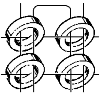26.1.2000 News from the LGP-30
("No. 4 lives")
The faulty instructions Y and R
First, it seemed that the Y instruction (address replacement) and R instruction (store return address) didn't work at all. By experimenting we found out that this was not correct: both instructions did write the address part to the drum, but not into the word addressed by the instructions, but rather into the physically after next word following the instruction. Measurements with the logic analyser revealed that with these instruction, phase 3 where the addresses operand is located is only one word time long, as with the two jump instructions, and then terminated. That is correct for the jumps, but in conjunction with the Y and R instructions this leads to the fault described above. Unfortunately this knowledge did not help to find the component causing this failure.
On january 18 it was christmas again: the Schelztor highschool in Esslingen donated its relicts from their LGP-30:
- The magnetic drum
- The logic board
- 3 tube modules
- A great number of papertapes with essentially the complete software
distribution that existed for the LGP-30:
~ ACT-V, all important library routines (9.0, 10.4 and many more) - a lot of documentation
Some diodes were broken on the logic board. We replaced them courageously with 1N4001 (how embarrassing) and put the Schelztor board in the computer. And see: with the Schelztor board the instructions Y and R worked!
To further test the computer we read some papertapes, the Black Jack program, the 5x5 magic squares program and the Pi program. Each program seemed to work fine at the first glance. We didn't know the rules of this Black Jack so the computer always won, the squares looked really magic and Pi was calculated to 60 places although 50 were requested. No. 4 didn't gave up after 60 places but the result was wrong from that point on.
Now, clearly the Y-R fault was on the original logic board and we hoped to find it there, too.
Because everything was working so nicely and we had so much software to try we tried last thursday (20.1.) to attach the highspeed papertape reader. The reader itself worked, i.e. the characters were correclty read into the accumulator of the machine, but the reader then disturbed the operation of all following instructions that didn't have anything to do with I/O in such an efficient way that the whole program went amok. Apparently phase 2 "copy the cell found into the instruction register" was perturbed.
